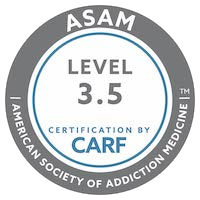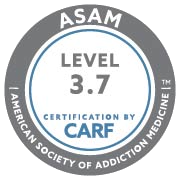Someone who has experienced one or more traumatic events may find themselves continuing to struggle with the effects of it long after the event has occurred. Symptoms such as irritability, hostility, and hypervigilance can impact their day-to-day behaviors, as can social isolation and loss of interest in the things they used to like. Some of the most painful symptoms that trauma can cause can include nightmares, flashbacks, crippling anxiety, and fear. When the effects that trauma can bring are not properly addressed, these symptoms can negatively affect their lives tremendously.
The National Council for Behavioral Health reports that 70% of adults experience at least one traumatic event in their lives. That equals out to roughly 225 million people of the 328 million people living in the United States. Of those hundreds of millions of people are individuals who are also experiencing a co-occurring substance use disorder. In fact, those who seek treatment for trauma are 14 times more likely to be diagnosed with a substance use disorder.
What Events are Traumatic?
Traumatic experiences can actually change the functionality of the brain. For example, when a traumatic event occurs, the amygdala creates a fight-or-flight response in the body. The amygdala is a part of the brain that is responsible for alerting a person of threat and sending signals to help deal with that threat. When a traumatic event happens, the amygdala releases that fight-or-flight reaction and then remembers to do so next time the traumatic event occurs or something like it occurs. The prefrontal cortex, which is in charge of regulating emotions and decision-making, becomes affected by the traumatic event and does not function as it is supposed to. Therefore, when the amygdala produces over-reactionary responses to trauma, the prefrontal cortex is not able to fully process those responses or act on them. This can result in symptoms such as impulsivity and hypervigilance.
So, what events cause trauma? Ranging from children to elderly individuals, traumatic events can occur anywhere at any time. Some of the most common traumatic events that people experience include, but are not limited to, the following:
- Physical abuse
- Mental abuse
- Emotional abuse
- Sexual abuse (including rape and sexual assault)
- Witnessing any type of abuse
- Community violence (presence of gangs, frequent robberies or muggings)
- Abandonment
- Neglect
- Combat exposure
- Bullying (including cyber-bullying)
- Natural disasters such as hurricanes, tornadoes, wildfires, floods
- Serious physical injuries that result from events such as car accidents, animal attacks, etc.
- Severe health conditions such as cancer
- Terrorism (both domestic and international)
- Being a victim of racism, sexism, or LGBTQ+ abuse
Some people may experience one traumatic event in their lives, while others may experience several. Unfortunately, trauma affects the brain no matter what the specific traumatic event is. The three types of trauma include:
- Acute trauma – when one traumatic event is experienced
- Chronic trauma – when repeated and prolonged exposure to trauma is experienced (e.g. being a victim of domestic violence)
- Complex trauma — when multiple traumatic events are experienced
Who Experiences Trauma?
Trauma can happen at any time, at any age, and to anyone. This means that children, adults, elderly individuals, and even babies can suffer the effects of a traumatic event.
As mentioned before, approximately 70% of Americans experience one or more traumatic events in their lifetime. Men are at higher risk for experiencing trauma than women are, however it affects both genders almost equally. Trauma impacts 60% of men and 50% of women. This means that 6 out of every 10 men and 5 out of every 10 women experience at least one traumatic event.
While trauma is something that can happen to anyone, there are a handful of individuals who tend to experience trauma more frequently than the average American, such as:
How is Trauma Treated?
Specific to members of the military, rates of trauma are exceptionally high, as are rates for posttraumatic stress disorder. Given the circumstances of the profession, it is unlikely that those who join the military will not witness or experience a traumatic event. That is why rates of PTSD are so high in this population. The United States Department of Veterans Affairs reports the following rates of PTSD per recent wars:
- Operations Iraqi Freedom and Enduring Freedom — 11-20% of military members developed PTSD
- Gulf War — 12% of military members developed PTSD
- Vietnam War — 15% of military members developed PTSD
HEROES Program
At Hathaway, we offer trauma therapy for those individuals who have served our country in one way or another. We also offer first responder programs. We realized that PTSD, substance use disorders, and other mental illnesses are common in these careers given the requirements, which is why we are able to provide services to our nation’s heroes.
Through the HEROES program, we ensure that all service members, their families, and veterans are afforded the best possible trauma therapy. We believe that professional treatment services should be easily accessible to these individuals, which is why we have partnered with TRICARE at our trauma therapy Los Angeles. TRICARE offers coverage for the following:
- Active-duty servicemembers and their families
- National Guard/Reserve members and their families
- Retired service members and their families
- Retired Reserve members and their families
- Beneficiaries
- Survivors
- Children
- Former spouses
- Medal of Honor recipients
- Dependent parents and parents-in-law
- Foreign force members and their family
Hathaway also accepts several different types of insurance so that those who need help the most can get it easily.
Hathaway Residential Inpatient Treatment Planning:
Residential Inpatient Treatment planning occurs within the first seven days of admission to this level of care. The plan is then reviewed and revised with the patient again within every seven days during individual sessions. The Clinical Director assesses each developed treatment plan and approves or requires adjustment. The Clinical Director may make suggestions to the patient’s clinician and work closely with the patient should the treatment plan need revisiting
During initial assessments, particularly during a biopsychosocial assessment and individual sessions, areas of the patient’s life affected by substance use are identified. These identified areas lay the foundation for the next level of care and engagement in treatment. The areas affected break down by ASAM’s six dimensions and are the foundation of a healthy treatment plan.
As the counselor and patient explore the areas of life that are affected by the disease, the severity of each dimension is also identified. This allows the patient and clinician to work out what goals to set first, second, and so forth and then break each one down into smaller, timebound steps. For example, should the patient have mental health issues, those would be one of the first goals to address so that the patient is stabilized, can participate fully and experience an expeditious and then, long-term improved quality of life. Steps might include being seen by a psychiatrist, obtaining prescribed medications and taking those medications as prescribed, engaging in therapy with a qualified therapist and participation in ongoing individual sessions and assessment.
For as long as Hathaway has the patient within our care, we continue treatment planning on a weekly basis with clinical review and staff input during staff meetings. Updates to the plan are made and the patient is always acknowledged for their progress or, supported in meeting whatever step may be causing a barrier to progress; potentially breaking steps down further or, walking closely with the patient through the step causing difficulty.








